 W
WAdriana of Nassau-Dillenburg was a daughter of Count John IV of Nassau-Dillenburg and his wife Maria of Loon-Heinsberg.
 W
WAgnes II was a member of the House of Wettin who reigned as Princess-Abbess of Quedlinburg.
 W
WAgnes of Loon (1150–1191), was a duchess consort of Bavaria, married to Otto I of Wittelsbach, Duke of Bavaria. She was regent of Bavaria during the minority of her son, Louis I, Duke of Bavaria, from 1183 to 1191. She was the daughter of Louis I, Count of Loon, and Agnes of Metz. Agnes was described as a forceful regent, who managed to secure the inheritance of her son.
 W
WAgnes of Rheinfelden was the daughter of Rudolf of Rheinfelden, and the wife of Berthold II of Zähringen.
 W
WAgnes of Rochlitz came from the Wettin family and was daughter of Dedi III, Margrave of Lusatia and his wife, Matilda of Heinsburg. She is also known as Agnes of Wettin.
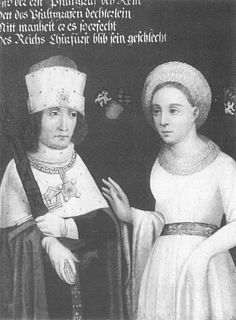 W
WAgnes of the Palatinate (1201–1267) was a daughter of Henry V, Count Palatine of the Rhine and his first wife Agnes of Hohenstaufen, daughter of Conrad, Count Palatine of the Rhine. Agnes was Duchess of Bavaria by her marriage to Otto II Wittelsbach, Duke of Bavaria.
 W
WAnna of Brunswick-Grubenhagen-Einbeck was a daughter of Duke Eric I of Brunswick-Grubenhagen and his wife, Elisabeth of Brunswick-Göttingen.
 W
WAnna of Eppstein-Königstein was the daughter of Philip I of Eppstein-Königstein and his wife, Louise de la Marck.
 W
WAnna of Isenburg-Büdingen was a German noblewoman. She was a daughter of Count Louis II of Isenburg-Büdingen and Countess Maria of Nassau-Wiesbaden-Idstein.
 W
WAnna of Austria (1275–1327) was a daughter of Albert I of Germany and his wife Elisabeth of Tirol. She was a member of the House of Habsburg.
 W
WAnne of Bohemia, also known as Anna of Luxembourg, was a daughter of John of Bohemia and his first wife, Elizabeth of Bohemia. Anne was a member of the House of Luxemburg.
 W
WBeatrice I, also known as Beatrice of Franconia, was Abbess of Gandersheim Abbey from 1043 and Princess-Abbess of Quedlinburg Abbey from 1044 until her death.
 W
WBeatrice of Silesia was a Polish princess member of the House of Piast in the Silesian branch of Jawor-Świdnica and by marriage Duchess of Bavaria and German Queen.
 W
WAgnes Bernauer was the mistress and perhaps also the first wife of Albert, later Albert III, Duke of Bavaria. Because his father, Ernest, ruling Duke of Bavaria at the time, considered this liaison with a commoner unbefitting his son's social standing, he clashed with his son over the matter and finally arranged to have Agnes condemned for witchcraft and drowned in the Danube in 1435. Her life and death have been depicted in numerous literary works, the most well known being Friedrich Hebbel's tragedy of the same name and the folk musical Die Bernauerin by the composer Carl Orff.
 W
WBertha of Savoy, also called Bertha of Turin, a member of the Burgundian House of Savoy, was Queen consort of Germany from 1066 and Empress consort of the Holy Roman Empire from 1084 until 1087 as the first wife of the Salian emperor Henry IV.
 W
WBlanche of Valois was a Queen consort of Germany and Bohemia by her marriage to King and later Holy Roman Emperor Charles IV. She was the youngest daughter of Charles of Valois and his third wife Mahaut of Châtillon.
 W
WCatherine of Austria was a daughter of Albert I of Germany and his wife Elisabeth of Tirol. She was a member of the powerful House of Habsburg. She was Duchess of Calabria by her marriage.
 W
WCatherine of Gorizia was a daughter of Count Meinhard VI of Gorizia and his first wife Catherine of Pfannberg.
 W
WCatherine of Henneberg was a Countess of Henneberg by birth and from 1347 by marriage Margravine of Meissen, Landgravine of Thuringia, etc. She was the wife of Margrave Frederick the Severe of Meissen. Via her, the House of Wettin inherited her father's Franconian possessions.
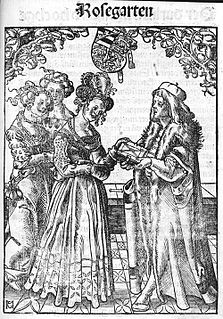 W
WCatherine of Pomerania-Wolgast was the wife of Henry IV, Duke of Brunswick-Lüneburg, Prince of Wolfenbüttel. She was the daughter of Eric II, Duke of Pomerania-Wolgast, and Sophia of Pomerania-Stolp.
 W
WChristina of Stommeln, also known as Christina Bruso and Christina Bruzo, was a Roman Catholic mystic, ecstatic, and stigmatic.
 W
WClaricia or Clarica was a 13th-century German illuminator. She is noted for including a self-portrait in a South German psalter of c. 1200, now in The Walters Art Museum, Baltimore. In the self-portrait, she depicts herself as swinging from the tail of a letter Q. Additionally, she inscribed her name over her head.
 W
WClemence of Austria was a daughter of King Rudolph I of Germany and Gertrude of Hohenberg. She was a member of the House of Habsburg.
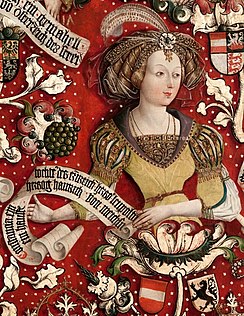 W
WConstance of Babenberg, a member of the House of Babenberg, was Margravine of Meissen from 1234 until her death, by her marriage with Margrave Henry the Illustrious.
 W
WConstance I was Queen regnant of Sicily in 1194–98, jointly with her spouse from 1194 to 1197, and with her infant son Frederick II, Holy Roman Emperor, in 1198, as the heiress of the Norman kings of Sicily. She was also Holy Roman Empress by marriage to Henry VI, Holy Roman Emperor.
 W
WElizabeth of Moravia was the second daughter and third issue of John Henry of Moravia, and his second wife Margaret of Opava. She became Margravine consort of Meissen by her marriage to William I, Margrave of Meissen (1366).
 W
WElisabeth of Nuremberg was the daughter of Frederick V, Burgrave of Nuremberg and Elisabeth of Meissen. She was a member of the House of Hohenzollern, and the wife of Rupert of Germany. In 1398, she became the Electress of the Palatinate of the Rhine, and in 1400 she became Queen of the Romans.
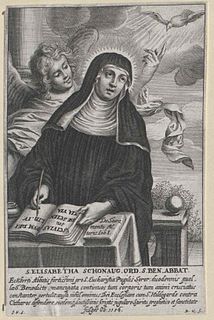 W
WElisabeth of Schönau was a German Benedictine visionary. She was an abbess at the Schönau Abbey in the Duchy of Nassau, and experienced numerous religious visions, for which she became widely sought after by many powerful men as far away as France and England.
 W
WElizabeth of Lorraine-Vaudémont, Countess of Nassau-Saarbrücken was a pioneer of the novel in Early New High German language. Around 1437, she translated and edited four French romances by Odo Arpin of Bourges, Sibille, Loher & Maller and Hug Chapler.
 W
WGerberga II, was the daughter of Henry I of Bavaria and his wife Judith, and a niece of Emperor Otto I. She was Abbess of Gandersheim from 956 to 1001 and personally instructed dramatist and poet Hrosvit of Gandersheim. Under Gerberga's rule, Gandersheim Abbey served as an Ottonian center of cultural, spiritual, and intellectual life.
 W
WGertrude Anne of Hohenberg was German queen from 1273 until her death, by her marriage with King Rudolf I of Germany. As queen consort, she became progenitor of the Austrian House of Habsburg.
 W
WGertrude of Sulzbach was German queen from 1138 until her death as the second wife of the Hohenstaufen king Conrad III.
 W
WGertrude of Süpplingenburg was, by her two successive marriages, Duchess of Bavaria from 1127 to 1138, Margravine of Tuscany from 1136 to 1139, and Duchess of Saxony from 1137 to 1138, Margravine of Austria and again Duchess of Bavaria until her death. She was regent of Saxony during the minority of her son in 1139-1142.
 W
WGisela of Swabia, a member of the Conradiner dynasty, was queen of Germany from 1024 to 1039 and empress of the Holy Roman Empire from 1027 to 1039 by her third marriage with Emperor Conrad II. She was the mother of Emperor Henry III. She was regent of Swabia for her minor son Duke Ernest II of Swabia in 1015.
 W
WHedwig of Brandenburg, also called Hedwig of Ballenstedt, a member of the House of Ascania, was Margravine of Meissen from 1156 until 1190 by her marriage with Margrave Otto II.
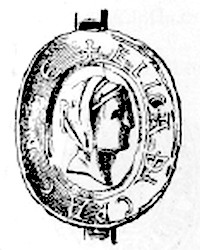 W
WHeilika of Pettendorf-Lengenfeld was by marriage Countess Palatine of Bavaria.
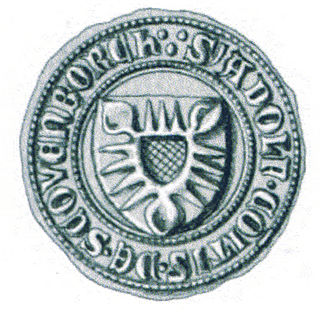 W
WHeilwig of Lippe, also known as Heilwig of Schaumburg was a German noblewoman.
 W
WEmma of Altdorf, also known as Hemma, a member of the Elder House of Welf, was Queen consort of East Francia by marriage to King Louis the German, from 843 until her death.
 W
WBorn in Gandersheim to Saxon nobles Hrotsvitha was a German secular canoness, who wrote dramas and poems during the rule of the Ottonian dynasty. Hrotsvitha lived at Gandersheim Abbey. She is considered the first female writer from the German Lands, the first female historian, the first person since antiquity to write dramas in the Latin West, and the first female poetess in Germany.
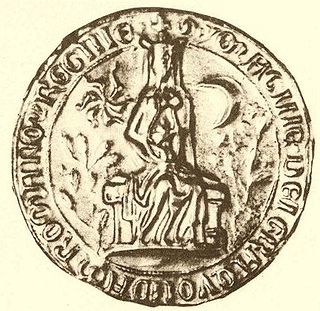 W
WImagina of Isenburg-Limburg was the Queen consort of Adolf of Nassau, King of Germany.
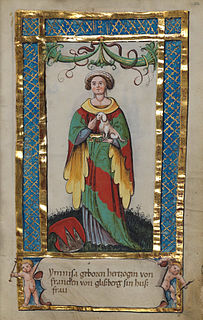 W
WImiza of Luxembourg, was a German noblewoman. She was the daughter of Frederick of Luxembourg, and the wife of Welf II of Swabia.
 W
WBlessed Irmgard of Chiemsee, a member of the Carolingian dynasty, was the second daughter of King Louis the German and his wife Hemma. She was the first Abbess of Frauenchiemsee from 857 until her death.
 W
WKatharina of Schwarzburg-Blankenburg was the wife of Count Reinhard IV of Hanau-Münzenberg.
 W
WKunigunde of Altdorf was a member of the Swabian line of the Elder House of Welf. She was also the ancestress of the younger House of Guelph, a cadet branch of the House of Este.
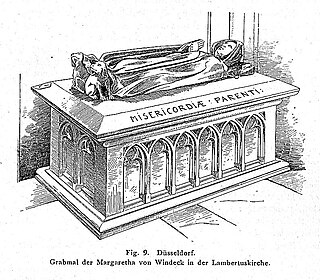 W
WMargaret of Berg-Windeck was a German noblewoman.
 W
WMargaret of Brabant, was the daughter of John I, Duke of Brabant and Margaret of Flanders. She was the wife of Henry, Count of Luxembourg, and after his election as King of Germany in 1308, she became Queen of Germany.
 W
WMargaret of Sicily was a Princess of Sicily and Germany, and a member of the House of Hohenstaufen. By marriage she was Landgravine of Thuringia and Countess Palatine of Saxony.
 W
WMargarete of Saxony was a Saxon princess of the Ernestine line of the house Wettin by birth and by marriage a Duchess of Brunswick-Lüneburg.
 W
WMaria of Brabant, a member of the House of Reginar, was Holy Roman Empress from 1214 until 1215 as the second and last wife of the Welf emperor Otto IV.
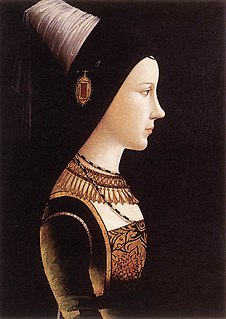 W
WMary, Duchess of Burgundy, reigned over the Burgundian State, now mainly in France and the Low Countries, from 1477 until her death in a riding accident at the age of 25.
 W
WMatilda of Brandenburg, a member of the House of Ascania, was first Duchess consort of Brunswick-Lüneburg from 1235 to 1252 by her marriage with the Welf duke Otto the Child.
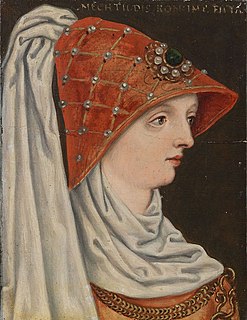 W
WMatilda of Habsburg or Melchilde was, by marriage, a duchess of Bavaria. She was regent of Bavaria in the minority of her son, Rudolf I.
 W
WMatilda (Mechtilde) of Savoy (1390–1438) was a daughter of Amadeo, Prince of Achaea and Catherine of Geneva. She was the second wife of the Elector Palatine Louis III, whom she married on 30 November 1417.
 W
WMatilda of Swabia, a member of the Conradine dynasty, was Duchess of Carinthia by her first marriage with Duke Conrad I and Duchess of Upper Lorraine by her second marriage to Duke Frederick II. She played an active role in promoting her son, Duke Conrad the Younger, as a candidate for the German throne in 1024 and to this end corresponded with King Mieszko II of Poland.
 W
WSibylle of Baden was a Margravine of Baden by birth and by marriage, Countess of Hanau-Lichtenberg. She was a daughter of Margrave Christoph I of Baden and his wife, Countess Ottilie of Katzenelnbogen, the daughter of Philip the Younger of Katzenelnbogen and thus a granddaughter of Philipp I, Count of Katzenelnbogen.
 W
WSophia of Wittelsbach (1170–1238) was a daughter of Otto I Wittelsbach, who was Count Palatine and later Duke of Bavaria, and his wife Agnes of Loon.
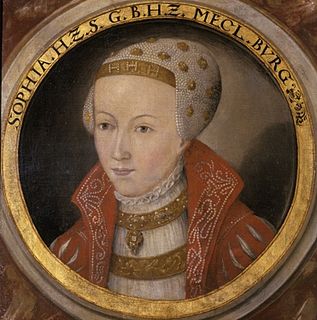 W
WSophie of Mecklenburg, also spelled Sophia was a German noblewoman. She was a Duchess of Mecklenburg by birth and by marriage Electoral Princess of Saxony.
 W
WSophie of Saxe-Lauenburg was a German regent, Duchess of Jülich-Berg by marriage to Gerhard VIII of Jülich-Berg, and regent of Jülich, Berg and Ravensberg for her eldest son William IV from 1456 until 1473.